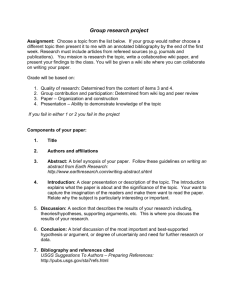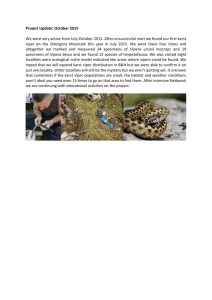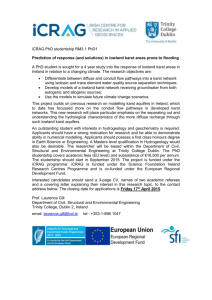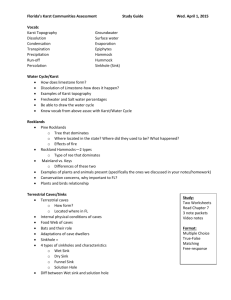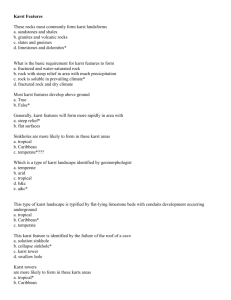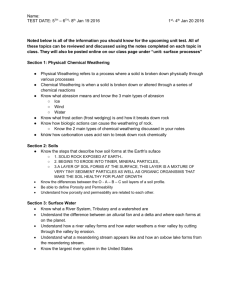Štev: 001-5- 115/97-DK - Food and Agriculture Organization of the
advertisement
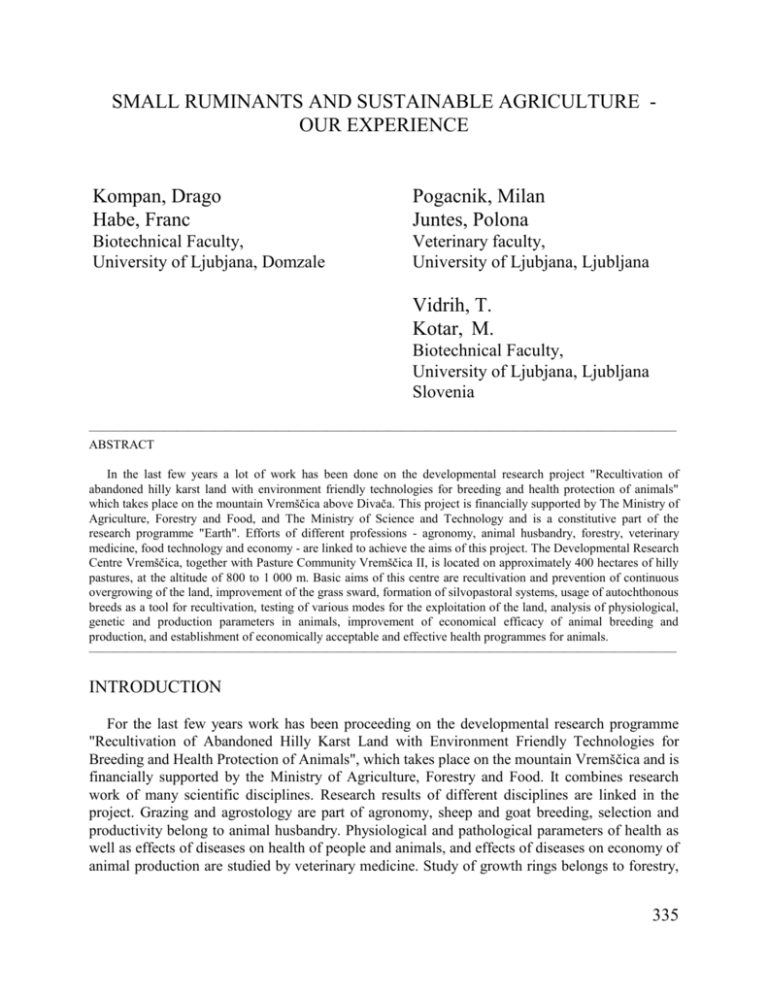
SMALL RUMINANTS AND SUSTAINABLE AGRICULTURE OUR EXPERIENCE Kompan, Drago Habe, Franc Pogacnik, Milan Juntes, Polona Biotechnical Faculty, University of Ljubjana, Domzale Veterinary faculty, University of Ljubjana, Ljubljana Vidrih, T. Kotar, M. Biotechnical Faculty, University of Ljubjana, Ljubljana Slovenia ——————————————————————————————————————————————— ABSTRACT In the last few years a lot of work has been done on the developmental research project "Recultivation of abandoned hilly karst land with environment friendly technologies for breeding and health protection of animals" which takes place on the mountain Vremščica above Divača. This project is financially supported by The Ministry of Agriculture, Forestry and Food, and The Ministry of Science and Technology and is a constitutive part of the research programme "Earth". Efforts of different professions - agronomy, animal husbandry, forestry, veterinary medicine, food technology and economy - are linked to achieve the aims of this project. The Developmental Research Centre Vremščica, together with Pasture Community Vremščica II, is located on approximately 400 hectares of hilly pastures, at the altitude of 800 to 1 000 m. Basic aims of this centre are recultivation and prevention of continuous overgrowing of the land, improvement of the grass sward, formation of silvopastoral systems, usage of autochthonous breeds as a tool for recultivation, testing of various modes for the exploitation of the land, analysis of physiological, genetic and production parameters in animals, improvement of economical efficacy of animal breeding and production, and establishment of economically acceptable and effective health programmes for animals. ——————————————————————————————————————————————— INTRODUCTION For the last few years work has been proceeding on the developmental research programme "Recultivation of Abandoned Hilly Karst Land with Environment Friendly Technologies for Breeding and Health Protection of Animals", which takes place on the mountain Vremščica and is financially supported by the Ministry of Agriculture, Forestry and Food. It combines research work of many scientific disciplines. Research results of different disciplines are linked in the project. Grazing and agrostology are part of agronomy, sheep and goat breeding, selection and productivity belong to animal husbandry. Physiological and pathological parameters of health as well as effects of diseases on health of people and animals, and effects of diseases on economy of animal production are studied by veterinary medicine. Study of growth rings belongs to forestry, 335 and milk processing and quality of meat are part of the food processing industry. Agro-political effects of environmental control, multifunctional aspects of agriculture on the karst and hilly lands and some macro-economic analyses set to agrarian economy. FOUNDATION OF DEVELOPMENTAL RESEARCH CENTRE Economical efficacy of agricultural production is shown in natural, social and economic conditions that are not favourable to agricultural activities. When there are no more resources to support agriculture, lands are abandoned and production omitted, which result in migration. The mentioned processes are most evident in the hilly and Karst regions of our country, where the natural conditions are not favourable to agriculture, so the idea for the foundation of the Developmental Research Centre on the mountain Vremščica was born. The main objective of the Centre is to affirm knowledge and skills that are necessary to use and maintain agricultural activities on those areas. Planned research, technological and educational activities of the Centre will contribute to solve problems of abandoned karst and hilly areas and to support agricultural production in the hilly and karst regions as well as to promote recent foreign and domestic research results. Social and economic changes in the last 50 years have changed the way of living as well as most people's activities and values. The most stricken were agricultural lands in the marginal areas that are not very suitable for agricultural production. Spacious meadows and pastures have remained uncultivated. The most evident example of such process is Slovene Karst where more than 30 000 ha of agricultural lands have been overgrown, and the process has not finished yet. In Slovenia nearly 300 000 ha of pastures are endangered. The landscape has been losing its diversity, vicissitude of plants, wood fires are frequent, climate is changing (moisture) and lands are impervious and hostile due to abundant shrubs. The number of small ruminants has been diminished ten times in the last hundred years in Slovenia, and the reason is migrations. Karst was one of the essential problems in the previous centuries owing to disappearing forests, but today nearly 50 percent of the area are forests. In the previous century every hectare of the forest was very precious while now, on the contrary, every hectare of land that is saved from overgrowing is even more precious. The more forests and abandoned meadows there are, the more imminent danger of fires that can spread over huge areas exists. Unfortunately the areas are impervious to fire brigades. Farming should be the most important aspect of planning, maintenance and formation of environment. Unfortunately modest, steep and endangered areas like hilly areas and karst are not financially attractive since people can earn their living in the other sectors. Our main objective is to enable agricultural activities on those areas that are not very suitable for agriculture but which will help to keep our country stable and attractive. On that area food can be produced in a sustainable way and vast areas will be cultivated again. People who will live there or occasional visitors will feel good. 336 DESCRIPTION AND AIMS OF THE CENTRE The Developmental Research Centre Vremščica and Pasture Community Vremščica II are spread out on about 400 ha of mountainous pastures at an altitude between 800 and 1 000 m. At the moment about 20 ha of pastures are used for research work. Those pastures are fenced by electrical wires and equipped with water systems for animals. Research and developmental areas on mountain Vremščica. Trial areas are marked as Pasture 1 (3 ha), Pasture 2 (4.5 ha), Pasture 3 (12 ha), Pasture 5 (4.5 ha) and Pasture 6 (11 ha). Trials are performed on Pastures 1, 2 and 3. The aims of the Centre are to promote environment friendly technologies of animal husbandry, especially goat and sheep breeding. The Centre provides research on the hilly and karst areas but the research results will be useful for all farmers that graze their animals. Methodological and empirical approach to data collection enables study of systems. Using small ruminants to improve the sward and using the animals as a tool for environment control have already proven to be a suitable mode of friendly area usage. Using small ruminants to re-cultivate overgrown areas is certainly a friendly way of using karst and hilly areas. Nevertheless, the project is manifold and requires continual support and study. CONTENT AND AIMS OF CENTRE'S RESEARCH The project work on Vremščica has been divided into two phases. In the first phase 7.5 ha of pastures were cultivated and fenced and we divided them into sections. In the next phase 20-30 ha of areas were fenced and divided into 15 to 20 sections. Animals on pasture have been attended. Before the trials the original structure of sward and plants was observed on the trial areas, soil was analysed, on some sections shrubs were cleaned, and trees were planted as well as animals purchased and selected and their health conditions monitored. We would like to present some studies that are in progress on Vremščica. Grazing and agrostology Sward management is examined in few studies. Fertilization, lime addition, sowing of various kinds of legumes, grasses and herbs to improve the composition of sward and to supply the animals with nutritive and mineral matters make up part of those studies. At the same time productive ability of sward is examined. We study the effects of various modes of grazing on botanical composition of sward and on nutritive value of biomass as well as on production changes and stability of pastures. The aim of the Centre is to study divers modes of recultivation of the overgrown areas by grazing and to study the effects of different ways of breeding on production and health conditions of animals. Silvopastoral system and growth rings Silvicultural studies are very important because abandoned agricultural areas are being overgrown by forest vegetation that is an essential compound of hilly Karst pastures. The balance 337 between pastures and forests is an important part of a silvicultural system. We study trees on the overgrown areas, wood and total biomass as well as their gain. The aim of the study is to determine which trees can be planted on karst. One of the most important aims of the project is to prevent the overgrowing of pastures. Recultivation of pasture areas by clearing shrubs and trees is of fundamental importance. Hydrology Hydrological research and permeability of karst as well as water supply are studied. Two accumulation ditches have been constructed to supply water. Ditches were constructed in order to compare various materials, technologies and technical solutions for construction. Sheep are supplied with water from those ditches. The first ditch contains 607 cubic meters and the second one 245, which is a total of 852 cubic meters. About 700 to 1000 sheep can be supplied with water during a three month period of drought in summer. In the second ditch, water is collected on the natural area of 50 000 m2 while in the first ditch 400 m2 of area are covered by polyethylene (PEHD). Both ditches are filled in five to ten days. They are fenced by electric fence to prevent animals free access to ditches and to prevent various diseases. Animals drink water in a special trough. Animal health monitoring Several studies deal with animal health in the frame of research work in the Centre. We monitor health conditions and preventive measures, we take care of animals and we study the reasons for death of dead animals. Parasite control is very important to prevent infections with ectoparasites and endoparasites. We study those parasites that are present in the Centre. Among endoparasites the most dangerous are those that live in alimentary tract and Dicrocoelium dendriticum. Among ectoparasites, ticks are ominous because they transfer some viruses and rickettsiales. One of the studies that is connected with parasite control and food hygiene investigates the residues of antihelmitics in milk and meat. Some other studies investigate infectious diseases like mastitis, paratuberculosis, pseudotuberculosis, lysteriosis, hoof diseases and infections with slow viruses. Reproduction studies concern semen quality, freezing of foetuses and embryotransfer, reproductive disorders and parturition complications. The aim of the Centre is to establish an embryo bank to preserve the native sheep Istrska Pramenka. Specific genes that are resistant to various diseases, like infectious lameness, which is typical for some breeds, are searched. We should also mention those studies that investigate the influence of sward control on physiological changes in blood cells and biochemical composition of blood. Animal husbandry The main objective of animal husbandry is to preserve the native breeds and to study the production traits of various breeds and their crossbreeds. Being the native breed, Istrska Pramenka is of great importance. Milk production and reproductive traits of this breed as well as growth rate of their lambs are studied. Weight gains in diverse breeding conditions are studied 338 too. Yields of young sheep that graze on the fenced trial areas, in which restricted quantities and kinds of food are available and thus they have to clean overgrown areas, are compared to sheep that graze traditionally all day and have to walk several miles every day. Besides trials with sheep, a combined system of grazing, in which cleaning of pastures is carried out by sheep and goats, is also studied. From the point of view of breeding and productivity we can conclude that offspring can be used in the above mentioned grazing systems. They should be well cared for and controlled to prevent ill consequences on sward and animals. Production and marketing Experts study processing and development of quality products as well as milk and meat products and lamb sales. Some technological procedures of milk processing have already been improved. Economic analyses Each process of recultivation should be financially supported so that model solutions can be provided while economic analyses on macro-economic levels will show the efficacy of recultivation with different systems of breeding. Education, advising and knowledge transfer All studies are applied to practice and examined in practice. The aim of the Centre is to transfer research achievements into practice. Therefore, research and observation results are available to people who are interested in research results. The educational and advising role of the Centre is evident. Advisors, agricultural experts and veterinary doctors, students, pupils and farmers as well as all people who should be aware of natural legitimacy are welcome to the Centre. In the first phase of the project the Centre was visited by more than 1 500 registered visitors. The activities of the Centre were presented to them in the form of demonstrations, lectures, seminars and one or two days long outdoor exercises. Every year agricultural advisors visit the Centre, students of Biotechnical and Veterinary Faculties are among the organized visiting groups and some of them do the experimental part of their thesis in the Centre. CONCLUSION The Developmental Research Centre Vremščica is based on five professional fields that are linked together. They are animal and plant production, veterinary medicine, forestry and economy. The aim of the Centre is to study the possibilities and efficacy of recultivation of karst and hilly lands with such technologies as small ruminant breeding and usage where overgrowing would be prevented and cleaning of overgrown areas enabled. 339 REFERENCE Kompan, D. - Pogačnik, M. & Kotar, M. 1995. Uporaba avtohtonih mlečnih pasem ovc za kultiviranje opuščenih kraskih senožeti. In: Sodobno kmetijstvo 1995; 28:230-234. Kotar, M. - Kompan, D. & Pogačnik, M. 1995. Vloga gozda na Krasu. In: Sodobno kmetijstvo 1995; 28:243-254. Pogačnik, M. - Kompan, D. - Vidrih, T. - Kotar, M. & Matičič, B. 1995. Rekultiviranje opuščenih hribovitih kraških zemljišč z drobnico. In: Sodobno kmetijstvo 1995; 28:225-229. Vidrih, T. & Kotnik, T. 1995. Nadzorovana paša malih prežvekovalcev kot osnova za sonaravno kmetovanje. In: Sodobno kmetijstvo 1995; 28:235-242. Vidrih, T. - Pogačnik, M. - Kotar, M. - Juntes, P. - Kompan, D. - Krek, V. & Kotnik, T. 1995. Sylvopastoral Systems - Environmental, Agricultural and Economic Sustainability. In: Avignon, France, Cahiers Options Méditerranéennes, Zaragoza 1995; 12:139-142. Pogačnik,M. - Kompan, D. - Juntes, P. - Vidrih, T. & Kotar, M. 1996. Récultivation e révitalisation de karst en employant les petits ruminants. In: IV. Congeso de la Federacion Mediterranea de Sanidad y Produccion de Rumiantes (Fe.Me. S.P.Rum.). Murcia, Spain, 28.30. Marzo,1996. 340
